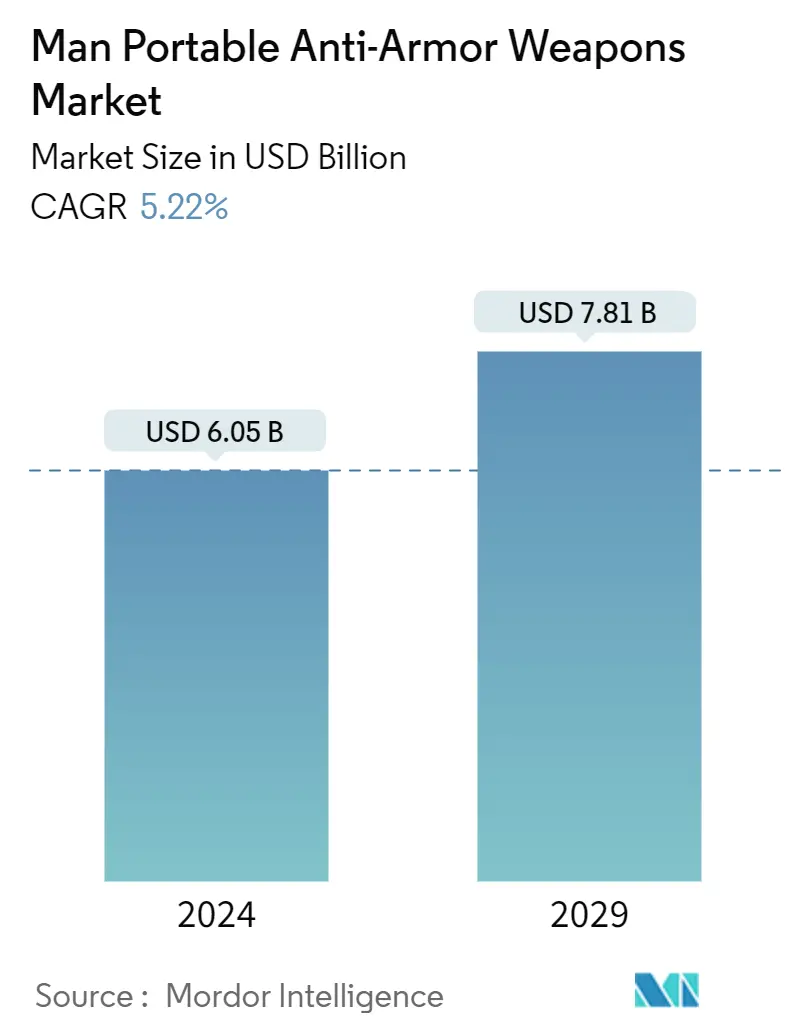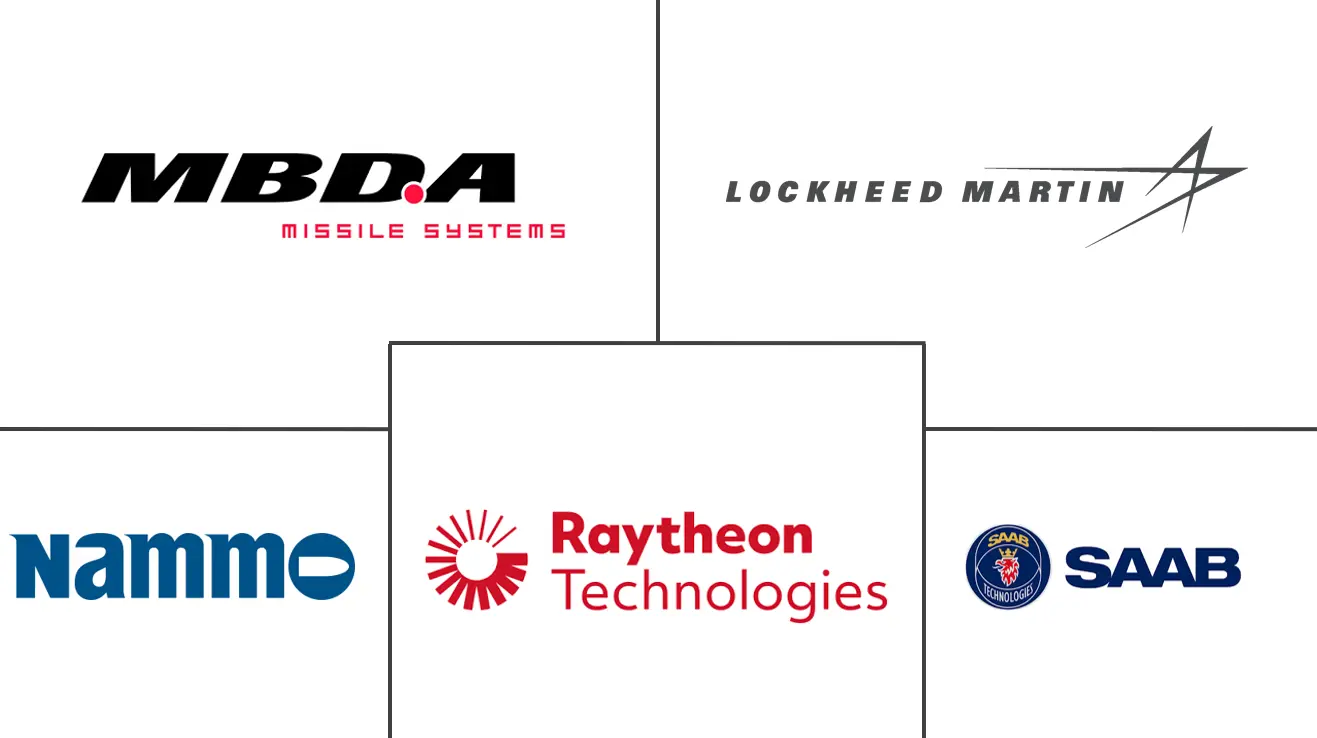Market Size of Man Portable Anti-Armor Weapons Industry

| Study Period | 2019-2029 |
| Market Size (2024) | USD 6.05 Billion |
| Market Size (2029) | USD 7.81 Billion |
| CAGR (2024 - 2029) | 5.22 % |
| Fastest Growing Market | Asia Pacific |
| Largest Market | North America |
Major Players
*Disclaimer: Major Players sorted in no particular order |
Man-portable Anti-armor Weapons Market Analysis
The Man Portable Anti-Armor Weapons Market size is estimated at USD 6.05 billion in 2024, and is expected to reach USD 7.81 billion by 2029, growing at a CAGR of 5.22% during the forecast period (2024-2029).
The roles of independent fighting groups are continuously evolving in modern battlefields. Data from recent combat operations reflect the high frequency of engagements with hostile weapon emplacements in various man-made and natural shelters that cannot be dominated solely using small arms or inferior firepower.
Man-portable anti-armor weapons are designed to confront these challenges while banking on their sophisticated features, such as extreme agility to react quickly to rapid changes in battlefield scenarios and adaptability to operate through diverse environments while ensuring total safety from various threats.
The market is expected to grow primarily due to the armed forces' procurement and upgrade activities to counter emerging threats. The growth is subjective to several associative factors, such as the allocation of funds for the procurement of new equipment.
However, it may be adversely affected due to the rapid technological advances resulting in the effective life of a newly developed technology. The limited range of man-portable anti-armor weapons, the challenges associated with the transfer of technology, and stringent regulatory frameworks and compliance requirements can pose challenges for manufacturers and limit the widespread deployment of these advanced weapons.
Technological advancements, such as precision-guided systems and enhanced targeting capabilities, contribute to the effectiveness of these weapons, making them crucial for military forces seeking to maintain a strategic edge. Moreover, the need for lightweight, easily deployable anti-armor solutions further propels the market forward, as military units prioritize mobility without compromising firepower.
Man-portable Anti-armor Weapons Industry Segmentation
Man-portable anti-armor weapons refer to shoulder-fired military weapons such as missiles, rifles, and grenades. Troops can transfer these anti-armor weapons easily from one site to another to destroy enemy battle tanks, planes, and other armored vehicles. These weapons are highly capable of destroying both static and moving targets.
The man-portable anti-armor weapons market is segmented based on technology, assembly type, weapon systems, and geography. Based on technology, the market is segmented into guided and unguided. By weapon systems, the market is segmented into man-portable air defense systems (MANPADS), anti-tank guided missiles (ATGMs), and rocket-propelled grenade launchers. The report also covers the market sizes and forecasts for the man-portable anti-armor weapons market in major countries across different regions. For each segment, the market size is provided in terms of value (USD).
| Technology | |
| Guided | |
| Unguided |
| Weapon Systems | |
| Man-portable Air Defense Systems (MANPADS) | |
| Rocket-propelled Grenade Launchers | |
| Anti-tank Guided Missiles (ATGMs) |
| Assembly Type | |
| Projectile | |
| Launcher |
| Geography | |||||||
| |||||||
| |||||||
| |||||||
| |||||||
|
Man Portable Anti-Armor Weapons Market Size Summary
The man-portable anti-armor weapons market is poised for significant growth, driven by the evolving dynamics of modern warfare and the increasing need for advanced military capabilities. These weapons are essential for engaging armored threats in diverse environments, offering agility and adaptability that are crucial in contemporary combat scenarios. The market's expansion is largely fueled by military procurement and upgrade activities aimed at countering emerging threats. However, challenges such as rapid technological advancements, limited weapon range, and stringent regulatory frameworks may impact market growth. Technological innovations, including precision-guided systems and enhanced targeting capabilities, are pivotal in maintaining the strategic edge of military forces, further propelling the demand for lightweight and easily deployable anti-armor solutions.
The market landscape is characterized by intense competition among prominent global defense systems and technology providers, with companies like General Dynamics Corporation, MBDA, RTX Corporation, Saab AB, and Lockheed Martin Corporation leading the charge. The Asia-Pacific region is anticipated to be the fastest-growing market, driven by increased military procurement in response to regional tensions, particularly in the South China Sea. The demand for anti-tank guided missiles (ATGMs) is on the rise, supported by advancements in armor technology and the need for effective counter-insurgency operations. Collaborative efforts among defense contractors and strategic partnerships, such as those seen in Poland and India, are indicative of the market's positive trajectory. Despite the competitive landscape, local players are gaining ground, leveraging technological advancements to challenge established global leaders.
Man Portable Anti-Armor Weapons Market Size - Table of Contents
-
1. MARKET DYNAMICS
-
1.1 Market Overview
-
1.2 Market Drivers
-
1.3 Market Restraints
-
1.4 Porter's Five Forces Analysis
-
1.4.1 Threat of New Entrants
-
1.4.2 Bargaining Power of Buyers/Consumers
-
1.4.3 Bargaining Power of Suppliers
-
1.4.4 Threat of Substitute Products
-
1.4.5 Intensity of Competitive Rivalry
-
-
-
2. MARKET SEGMENTATION
-
2.1 Technology
-
2.1.1 Guided
-
2.1.2 Unguided
-
-
2.2 Weapon Systems
-
2.2.1 Man-portable Air Defense Systems (MANPADS)
-
2.2.2 Rocket-propelled Grenade Launchers
-
2.2.3 Anti-tank Guided Missiles (ATGMs)
-
-
2.3 Assembly Type
-
2.3.1 Projectile
-
2.3.2 Launcher
-
-
2.4 Geography
-
2.4.1 North America
-
2.4.1.1 United States
-
2.4.1.2 Canada
-
-
2.4.2 Europe
-
2.4.2.1 United Kingdom
-
2.4.2.2 Germany
-
2.4.2.3 France
-
2.4.2.4 Russia
-
2.4.2.5 Rest of Europe
-
-
2.4.3 Asia-Pacific
-
2.4.3.1 India
-
2.4.3.2 China
-
2.4.3.3 Japan
-
2.4.3.4 South Korea
-
2.4.3.5 Rest of Asia-Pacific
-
-
2.4.4 Latin America
-
2.4.4.1 Brazil
-
2.4.4.2 Mexico
-
2.4.4.3 Rest of Latin America
-
-
2.4.5 Middle East and Africa
-
2.4.5.1 United Arab Emirates
-
2.4.5.2 Saudi Arabia
-
2.4.5.3 Turkey
-
2.4.5.4 South Africa
-
2.4.5.5 Rest of Middle East and Africa
-
-
-
Man Portable Anti-Armor Weapons Market Size FAQs
How big is the Man Portable Anti-Armor Weapons Market?
The Man Portable Anti-Armor Weapons Market size is expected to reach USD 6.05 billion in 2024 and grow at a CAGR of 5.22% to reach USD 7.81 billion by 2029.
What is the current Man Portable Anti-Armor Weapons Market size?
In 2024, the Man Portable Anti-Armor Weapons Market size is expected to reach USD 6.05 billion.

